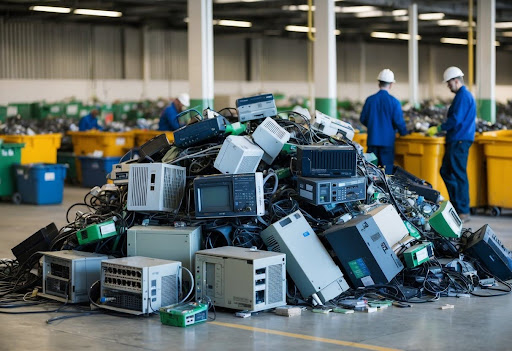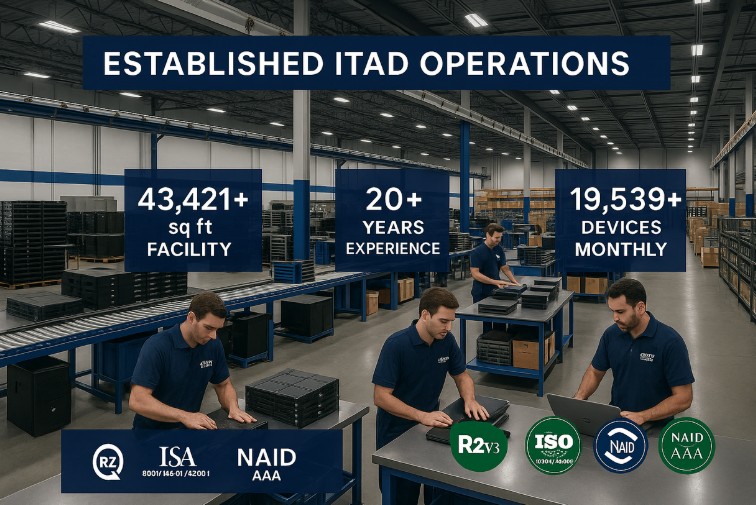Disposing of electronic waste comes with significant legal and environmental obligations that businesses can’t afford to ignore.
When companies discard old computers, phones, and other devices improperly, they face more than just environmental concerns. Improper electronics disposal exposes organizations to serious compliance risks, including data breaches, regulatory fines, and potential legal action from government agencies. These risks have increased as environmental directives become more stringent and data privacy laws more comprehensive.
The electronic waste industry involves several compliance challenges that affect your bottom line and reputation. From privacy concerns to corruption risks, the proper handling of IT assets requires careful planning and execution.
Electronic waste regulations cover everything from collection and storage to transport and final disposal, creating a complex web of requirements that vary by location and device type.
Understanding Compliance in Electronics Disposal
Electronics disposal involves following strict regulations to protect both the environment and sensitive data. Proper compliance reduces legal risks and promotes sustainable practices that benefit businesses and the communities they serve.
Regulatory Frameworks and Standards
The electronic waste industry operates under multiple regulatory frameworks including federal, state, and international regulations.
In the United States, the Environmental Protection Agency (EPA) classifies many electronic devices as either hazardous waste or universal waste depending on their components and disposal needs. Federal regulations like the Resource Conservation and Recovery Act (RCRA) establish basic handling requirements for hazardous materials found in electronics.
Many states have additional e-waste laws that ban electronics from landfills entirely.
International standards also apply to e-waste management. The Basel Convention restricts the movement of hazardous waste between countries, affecting how you and where electronics can be exported.
To maintain compliance, your business must understand which regulations apply to your specific electronic waste stream. Requirements may differ based on your industry, location, and the types of devices you dispose of.
Impact of Non-Compliance on Businesses
Failing to follow e-waste regulations can lead to serious consequences for your business.
Financial penalties for improper disposal can reach thousands or even millions of dollars depending on the severity and frequency of violations.
Non-compliance risks extend beyond immediate fines. Your company may face:
- Legal actions from regulatory agencies
- Reputational damage affecting customer trust
- Business disruptions during investigations
- Remediation costs to correct improper disposal
Data security breaches resulting from improper electronics disposal can trigger additional penalties under privacy laws like HIPAA or GDPR. These regulations require you to protect sensitive information even during disposal.
Many companies discover non-compliance issues during audits or when problems arise, often leading to unexpected costs and business interruptions.
Compliance Challenges
Managing electronic waste compliantly presents several challenges.
- Constantly changing regulations make it difficult to stay current with requirements across different jurisdictions where your business operates.
- Proper data sanitization remains a significant challenge. Before disposing of devices, you must ensure all sensitive information is completely removed to avoid data breaches.
- Tracking and documentation requirements add complexity. You need systems to:
- Maintain detailed inventory records
- Document chain of custody
- Generate certificates of destruction
- Keep disposal records for required periods
- Finding qualified recycling partners also creates challenges. Not all e-waste recyclers follow proper procedures, and using non-certified vendors may leave your business liable for downstream violations.
- Limited internal resources and expertise often make compliance difficult, especially for smaller businesses that can’t dedicate staff specifically to waste management responsibilities.
Electronic Waste and Its Consequences
Electronic waste is a growing problem that poses serious risks to both the environment and human health. Improper disposal of electronics releases toxic substances that can contaminate soil, water, and air.
Types of Electronic Waste
E-waste encompasses a wide variety of discarded electronic devices and components.
- Computers, smartphones, and tablets form the largest category, with millions being replaced annually due to rapid technological advancement.
- Large household appliances like refrigerators, washing machines, and air conditioners make up another significant portion of e-waste. These items contain harmful chemicals and materials that require special handling.
- Entertainment electronics such as TVs, gaming consoles, and audio equipment contribute substantially to the e-waste stream. The transition from analog to digital technology has accelerated disposal rates.
- Small electronic devices including cameras, GPS units, and electronic toys often end up in landfills despite containing valuable recoverable materials and toxic components.
- IT equipment like servers, routers, and printers from businesses represent a growing segment as companies regularly upgrade their infrastructure.
Environmental and Health Hazards
E-waste contains numerous toxic materials like lead, mercury, cadmium, and arsenic that can pose major risks to both the environment and public health.
- Soil and water contamination: When improperly handled, these substances contaminate ecosystems and destroy wildlife habitats.
- Air pollution from informal recycling: In developing countries e-waste is often handled by burning cables to recover copper, releasing harmful dioxins and furans into the air.These pollutants can travel long distances and persist in the environment for years.
- Human health risks: Workers in informal e-waste recycling face serious health risks including respiratory problems, skin disorders, and neurological damage.Without proper protection, exposure to these chemicals can cause long-term illness.
- Impacts on children and vulnerable populations: Children are particularly vulnerable to e-waste toxins, which can lead to developmental issues and chronic diseases.Communities near e-waste recycling sites often show elevated levels of toxic chemicals in blood samples.
- Climate change effects: The environmental impact extends to climate change, as some compounds in e-waste are potent greenhouse gases that contribute to global warming when released.
Best Practices in Electronic Waste Disposal
Implementing proper e-waste management practices helps organizations minimize environmental impact while meeting regulatory compliance requirements. Following these guidelines not only protects your company from potential fines but also enhances your reputation as an environmentally responsible business.
Proper Disposal Techniques
Start by developing a comprehensive e-waste disposal policy for your organization that outlines procedures for collecting, storing, and processing electronic waste.
- Ensure secure data removal: Before disposal,use certified data destruction methods like degaussing or physical destruction for hard drives containing sensitive information. This step is crucial for maintaining data security compliance.
- Segregate electronic waste by type: Keep batteries, screens, and circuit boards separate as they require different handling methods. This organization streamlines the recycling process and prevents hazardous materials from mixing.
- Provide collection points: Set up designated drop-off areas throughout your facility where employees can easily deposit unwanted electronics. Consider scheduling regular collection days to encourage participation in your e-waste program.
- Train all staff: Employees should understand proper handling procedures to prevent damage to recyclable components and avoid potential exposure to hazardous materials.
Recycling and Reuse Strategies
Not all equipment needs to be discarded immediately. Evaluate electronics for potential reuse before recycling as many devices can be refurbished or donated to extend their useful life. This approach is environmentally superior to immediate recycling.
Implement a tiered approach to electronics management:
- Level 1: Repair and reuse within your organization
- Level 2: Refurbish and donate to community organizations
- Level 3: Dismantle for parts recovery
- Level 4: Process for material recycling
Alternatively, consider establishing partnerships with manufacturers that offer take-back programs. Many electronics producers now provide recycling services for their products at end-of-life.
It’s also important to track your recycling metrics and set improvement goals. Measuring quantities of e-waste diverted from landfills helps quantify your environmental impact and identifies areas for improvement.
The EPA recognizes the inherent value of materials that can be reused, refurbished or recycled from electronics. Recovering valuable metals like gold, silver, and copper from circuit boards reduces the need for new mining operations.
Vendor Selection and Management
Choosing the right recycling partner is essential for maintaining regulatory compliance and protecting sensitive data.
- Partner with reputable e-waste recyclers that hold industry certifications like R2 (Responsible Recycling) standards to ensure proper handling practices.
- Request documentation of your vendor’s downstream processing chain. Responsible recyclers should provide transparency about where components end up after initial processing.
- Conduct site visits to recycling facilities before establishing partnerships. Direct observation helps verify that proper dismantling and material separation procedures are followed.
- Include environmental performance criteria in your vendor contracts. Specify acceptable processing methods and prohibited practices like informal dismantling or overseas shipping of hazardous materials.
- Review your vendor’s compliance history for any violations or enforcement actions.Past performance offers valuable insight into their commitment to regulatory compliance and environmental protection.
- Establish regular reporting requirements with your recycling partners. Request documentation of material volumes, processing methods, and final disposition to maintain your own compliance records.
The Role of the EPA and Other Regulatory Bodies
The Environmental Protection Agency (EPA) plays a central role in setting standards for electronics disposal in the United States.
Federal and international regulations work together to control how electronic waste is managed. Achieving full compliance requires understanding multiple overlapping frameworks.
Regulations and Guidance
The EPA considers e-waste to be a subset of used electronics and recognizes their potential value when reused or recycled properly.
Under the Resource Conservation and Recovery Act (RCRA), the EPA regulates household, industrial, and manufacturing solid and hazardous wastes, which includes many forms of electronic waste.
Your business may be subject to specific requirements depending on the volume and type of electronics you dispose of. Some states have created conditional exemptions from hazardous waste programs to encourage proper electronics recycling.
The international Basel Convention also affects how you can export used electronics, restricting shipments of hazardous e-waste to developing nations.
Monitoring and Enforcement
The EPA’s enforcement capabilities for e-waste have evolved, though gaps remain. According to government assessments, the EPA needs better control over harmful U.S. exports of electronic waste to reduce environmental damage in developing countries.
However, electronics recycling standards have brought more order and better management to the industry. The EPA’s implementation studies suggest a growing understanding of regulatory requirements and best practices among recyclers and businesses.
You should expect increasing scrutiny as monitoring technologies improve. Non-compliance can result in significant penalties, including:
- Civil fines up to $75,000 per violation per day
- Criminal prosecution for knowing violations
- Reputational damage from public enforcement actions
Data Security and IT Asset Disposition
Proper management of data security during IT asset disposition (ITAD) is critical for protecting sensitive information from unauthorized access. Implementing robust security measures throughout the ITAD process helps organizations prevent data breaches and maintain compliance.
Importance of Data Destruction
Data destruction is a crucial element of any ITAD strategy. When you dispose of electronic devices, you risk exposing sensitive information to unauthorized access.
This can lead to data breaches, identity theft, and significant compliance violations.
Why data destruction matters:
- Prevents recovery of confidential business information
- Protects customer and employee personal data
- Helps avoid costly regulatory penalties under laws like GDPR, HIPAA, and CCPA
- Maintains your organization’s reputation
Even after standard deletion, data can often be recovered from storage devices. This makes thorough data sanitization essential. You should ensure all data is completely unrecoverable through methods like secure wiping, degaussing, or physical destruction.
Secure ITAD Processes
Implementing secure ITAD processes requires a comprehensive approach to protect your data throughout the disposal lifecycle.
It must include a strict chain of custody procedures and continuous tracking of assets.
Key components of secure ITAD strategy:
- Asset inventory: Maintain detailed records of all IT equipment
- Chain of custody: Document handling at each stage of disposal
- Secure transport: Use locked containers and GPS tracking
- Certified data destruction: Apply appropriate methods based on sensitivity
- Verification: Receive certificates of data destruction
When selecting an ITAD partner, look for certifications like R2. These standards ensure your provider follows environmentally responsible disposal practices while maintaining data security.
Schedule regular audits of your ITAD processes to help identify and mitigate potential security risks before they lead to breaches. A proactive approach helps minimize compliance risks and strengthens your overall data protection strategy during IT asset disposal.
International Aspects of Electronics Disposal
Electronic waste crosses borders regularly, creating both legal challenges and human impacts. These international movements have significant consequences for compliance, environmental protection, and social justice.
Transboundary Movements and Controls
The Basel Convention serves as the primary international framework regulating e-waste movement across borders. It requires informed consent before hazardous waste shipments can cross national boundaries.
Despite these regulations, illegal trafficking of e-waste remains common. The United States is a major exporter of used electronics—some of which are legitimate for repair or refurbishment, while others improperly disguise disposal as “donation” or “recycling.”
Companies face serious compliance risks when their e-waste crosses borders improperly. Penalties can include fines, import bans, and reputational damage.
You should be aware that many countries have different standards for what constitutes hazardous electronic waste, making it critical to understand local and international regulations before shipping used equipment abroad.
Effects on Developing Nations
Developing countries often bear the heaviest burden of global e-waste—both legally and illegally—without adequate infrastructure to process them safely.
Informal recycling sectors have emerged in many regions, where workers—including children—extract valuable materials using dangerous methods.
You might be shocked to learn these practices expose communities to toxic substances like lead, mercury, and flame retardants. The environmental impact of improper e-waste disposal in these regions affects soil, water, and air quality. Contamination can persist for decades, affecting agriculture and drinking water supplies.
When planning your disposal strategy, consider that your company’s electronics might end up in these vulnerable communities if not properly managed through certified recyclers.
Managing the Risks of Non-Compliant Disposal
Proper e-waste management requires a proactive approach to identify potential risks and implement structured programs that ensure compliance. Taking deliberate steps now can prevent costly penalties and data breaches later.
Risk Identification and Mitigation
The first step in managing disposal risks is identifying what’s at stake.
Your organization faces multiple liability concerns when improperly disposing of electronics, including environmental damage fines, data breach penalties, and reputation harm.
Start by cataloging all electronic assets and their disposal requirements. Many devices contain hazardous materials like lead, mercury, and cadmium that require special handling. Then develop a risk matrix that ranks potential threats by likelihood and impact.
Common risks include:
- Data security breaches from improper media sanitization
- Environmental compliance violations leading to fines
- Brand damage from public disclosure of improper disposal
- Regulatory penalties from federal and state agencies
Your risk management strategy should include clear protocols for each device type and regular staff training.
Implementing a Compliant Electronics Recycling Program
A structured electronics recycling program forms the backbone of your compliance strategy.
Begin by designating a program coordinator responsible for oversight and compliance tracking.
Your program should include:
- Clear disposal policies for each device category
- Secure collection points throughout your facilities
- Vendor verification to ensure partners maintain proper certifications
- Data destruction procedures that meet NIST 800-88 or DoDstandards
Prioritize secure recycling practices including data erasure and storage device destruction to mitigate cybersecurity risks. Many organizations underestimate how data can persist on improperly wiped devices.
Maintain proper documentation for all disposed items, including:
- Certificates of data destruction
- Chain-of-custody records
- Asset inventory logs
This creates an audit trail that proves compliance with relevant e-waste regulations.
Audits and Continuous Improvement
Regular audits are essential to ensure your electronics disposal program remains effective and compliant.
Schedule quarterly internal reviews to verify all processes are working as designed.
Consider these audit approaches:
- Process audits: Examine how devices move through your disposal system
- Documentation reviews: Verify certificates and tracking records are complete
- Vendor assessments: Evaluate recycling partner compliance regularly
- Employee knowledge checks: Test staff understanding of protocols
Leverage audit findings to drive continuous improvement. According to recent GAO reports, organizations that regularly refine their disposal procedures face fewer compliance violations.
Key metrics to track:
- Percentage of properly disposed devices
- Training completion rates
- Incident occurrences
Set improvement targets for each metric and update your program based on emerging regulations and best practices to stay ahead of compliance requirements. Your proactive approach will minimize risks while demonstrating your commitment to responsible electronics management.
Consumer Education on Electronic Disposal
Many consumers are unaware of the harmful toxins in electronics and proper disposal methods. Better education can help reduce these risks and protect our environment.
Why proper disposal matters:
- Prevents toxic materials from entering landfills
- Recovers valuable materials for reuse
- Reduces environmental pollution
- Protects personal data security
Your understanding of e-waste regulations is crucial. Indiscriminate disposal of e-waste can harm both the environment and your health. These items should never be thrown in regular trash bins.
Local Recycling Programs and Safety Tips
Look for local take-back programs in your area. Michigan, for example, has implemented an Electronic Waste Take Back Program to provide convenient recycling options for residents.
Before disposal, remember to:
- Back up important data
- Completely wipe personal information
- Remove batteries (they may need separate disposal)
- Disconnect from cloud accounts
When recycling electronics, be aware of potential safety hazards from handling certain components. Always follow proper handling procedures to protect yourself.
You can find recycling events through local government websites, electronics retailers, or manufacturer take-back programs. Many companies now offer mail-back options for smaller devices.
Frequently Asked Questions
Navigating electronics disposal comes with many compliance questions that businesses need to address. These FAQs address common concerns to help businesses manage risk, maintain regulatory alignment, and implement effective e-waste strategies.
What are the legal requirements for the disposal of electronic devices?
Various regulations govern electronic waste disposal, and they differ by location. In the United States, many states have specific e-waste laws requiring proper disposal of electronics.
Companies must follow federal regulations like the Resource Conservation and Recovery Act (RCRA) when disposing of hazardous electronic components.
You should also check local regulations as they may be stricter than federal laws. For example, California’s Electronic Waste Recycling Act imposes additional requirements for handling certain types of devices.
How does improper e-waste disposal impact environmental compliance?
Improper disposal of electronics can lead to serious environmental contamination. When electronics are improperly handled, they can release harmful pollutants into air, land, and water.
These contaminants include heavy metals like lead, mercury, and cadmium which can persist in the environment for years.
Your organization may face substantial fines and remediation costs if found responsible for environmental damage caused by improper e-waste disposal.
What challenges do companies face when managing e-waste recycling programs?
Companies face many challenges when managing e-waste recycling programs. One major challenge is keeping up with constantly changing regulations across different jurisdictions.
Volume management can also be difficult, especially for large organizations that regularly replace substantial amounts of electronic equipment.
Finding reputable recycling partners who follow proper procedures and can provide documentation of compliance is another significant challenge.
Which specific electronics disposal methods ensure data privacy and security?
Sensitive data must be destroyed before devices leave your control. The most effective methods include:
Certificates of Destruction (CoD) to verify compliance with data sanitization requirements
NIST 800-88 compliant data wiping using certified software tools
Physical destruction of storage media through shredding or degaussing provides
These steps reduce the risk of data breaches and ensure alignment with privacy laws such as GDPR, HIPAA, and CCPA.
How can businesses mitigate the risks associated with e-waste disposal?
Developing a comprehensive electronics disposal policy that addresses both environmental and data security concerns is a crucial first step. This policy should be regularly updated.
Working with certified e-waste recyclers who hold R2 certifications helps ensure proper handling of your electronic waste.
Maintaining detailed records of all disposed electronics, including serial numbers, disposition dates, and certificates of recycling or destruction, provides essential documentation for compliance.
What penalties can organizations face for non-compliance in e-waste disposal?
Financial penalties for improper e-waste disposal can be substantial. They often reach tens or hundreds of thousands of dollars for serious violations.
In cases of willful violations, authorities may hold the company and individual decision-makers criminally liable.
Non-compliance could also lead to reputational damage and lost business opportunities. Many customers and partners now evaluate environmental responsibility in their business decisions.





